With his flute Hermes lulls Argus to sleep, who is guarding the nymph Io. She had been transformed by Zeus into a cow, so that his wife would not discover his adultery …
Oil on panel : 42,5 X 72,2 cm
Unsigned
Circa 1625/1628
Frame : 62,0 X 89,1 cm
"All paintings are fully documented with texts and photographs of comparative items. All this information is removed from our website once the painting is sold".
SOLD
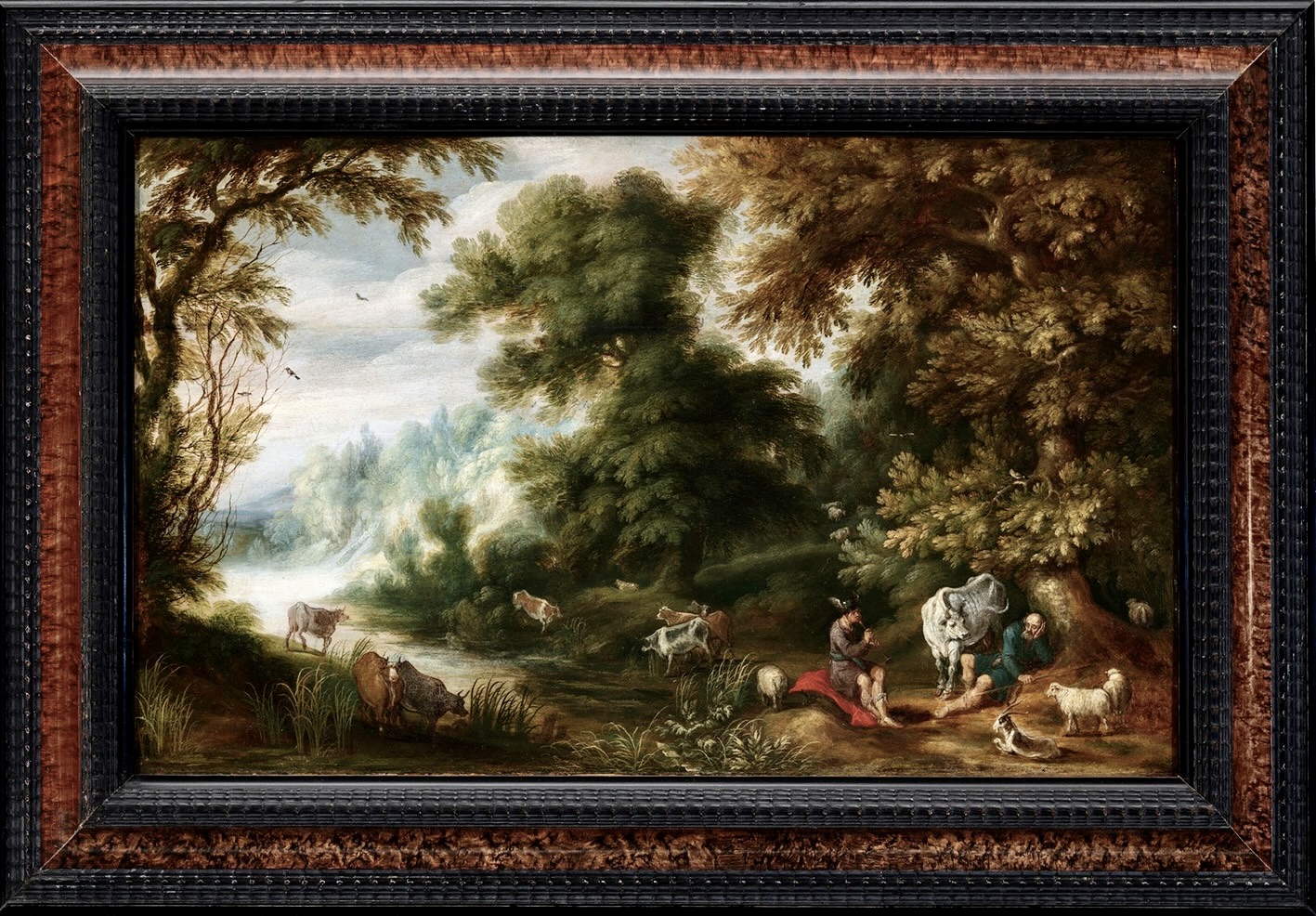
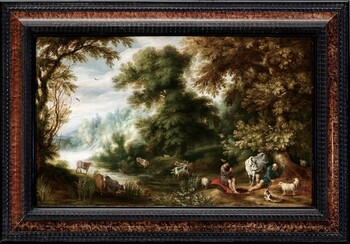
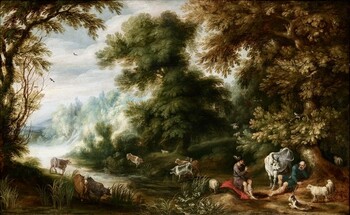
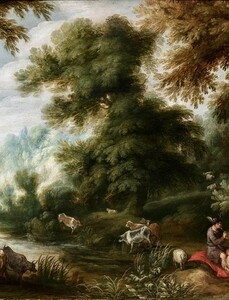
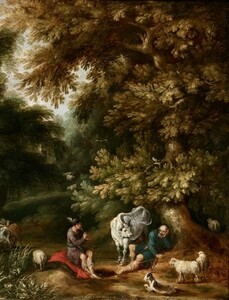
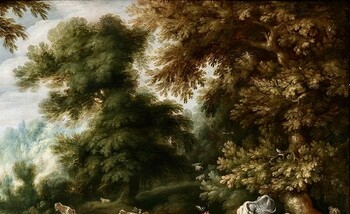
In short
This beautiful Flemish Mannerist landscape holds one of the great Greek myths, told to us by the Roman author Ovid. And yes, Graeco-Roman gods had very human character traits. It must date from Keirincx’s last years in Antwerp, circa 1625/1628, before he left for Holland.
About Alexander Keirincx
Flemish painter
Antwerp 1600 - 1652 Amsterdam
Forest landscape painter.
Pupil of Abraham Govaerts (1589 – 1626).
Already at the age of 19 Keirincx became Master in the Antwerp Guild of Saint Luke in 1619.
From 1628 on Keirincx lived in the Dutch Republic, in Utrecht and in Amsterdam. This move to a freer, richer, Protestant society was made by many of the early Flemish landscape, such as by Gillis van Coninxloo, David Vinckboons or Roelant Savery.
Towards the end of his life Keirincx settled as an art dealer and almost entirely stopped painting.
Keirincx regularly visited England: in 1639 and 1640 he painted views of British castles, houses and towns on commission from Charles I, King of England (1625 – 1649).
He usually worked in collaboration with colleagues, such as Cornelis van Poelenburgh, Frans Francken II, Pauwels van Hillegaert, Sebastiaen Vrancx and Esaias van de Velde, who painted the staffage figures in his landscapes.
His artistic production can be divided over three distinctive periods :
- his early works are inspired by Abraham Govaerts, Jan Brueghel the Elder and Gillis van Coninxloo, showing the typical Flemish, Mannerist three-color landscapes (in a codified succession of brown, green and blue) a horror vacui and an extreme sense of detail. At this stage of his career Keirincx can be considered the last of the Flemish Mannerist painters, being 66 years younger than Gillis van Coninxloo, 32 years than Jan Brueghel the Elder and 11 years than Abraham Govaerts.
- circa 1628 - 1630, under the influence of P.P. Rubens, his style became much more Baroque, pathetic and monumental : grotesque tree stems and distorted branches amid exuberant vegetation underscore the oppressive atmosphere. The coloring is less diverse.
- after 1640 he inscribes himself into the Dutch landscape tradition with an increasingly natural, classicizing approach: a lower horizon line, a monochromatic coloring, the woods are broader, and planted less compactly, there are no more distorted tree-stems.
About our painting
Our painting must date from Keirincx’s first period of activity when our young painter was still living in his hometown Antwerp: I would say from between 1625 and 1628.
In its sense for detail it reminds of the elder Flemish Mannerist painters who were still active in Antwerp, such as Abraham Govaerts (1589 – 1626), who was Keirincx's master, and of Jasper van der Lanen (circa 1592 – after 1629).
The composition, the treatment of the foliage and in fact the cows (which you may compare with the fully signed painting sold at Sotheby’s Amsterdam, 16/11/93) are typical of Keirincx.
The story of Io, Hermes and Argus
The ruler of the gods, Zeus (his Roman name is Jupiter), although married to Hera (her Roman name is Juno), had the bad habit of regularly falling in love with nymphs and mortal women.
One day he seduced/raped Io, daughter of the river god Inachus, in a cloud of fog. Hera saw this unnatural cloud from the top of Mount Olympus, home of the gods, and descended to earth. But Zeus had presented her coming and he was able to change Io into a beautiful cow.
Hera felt something was wrong here and asked to her husband for the cow as a present. She had Io guarded by Argus, who had 100 eyes: alternately 2 eyes slept while the others watched.
Poor Io stayed thus captured in the body of a cow. Zeus could not stand to see Io suffer this much and he ordered his son Hermes to kill Argus.
Hermes, dressed as a shepherd, made all Argus’ eyes fall asleep playing his flute and using his magic godly sceptre (this is the subject of our painting). Then he decapitated Argus with his sword. But Hera soon discovered what had happened: she took Argus’ 100 eyes to decorate the tail of her favoured animal, the peacock.
As to Io, still a cow, she had her persecuted by a horrible goddess of terror. Io finally reached the banks of the river Nile and looked up in despair to the sky, to Zeus … . He finally promised his wife he would never seduce another nymph nor woman again and so finally Io received back her appearance of a beautiful young nymph. She stayed in Egypt, bore a son, and was known there as the goddess Isis.
This Greek myth is told in the “Metamorphoses” by the famous Roman poet Ovid (Publius Ovidius Naso, 43 BC – 18 AD), a compilation of 250 Classical Greek myths written in Latin verses. These were translated in Dutch and published in 1604 by Karel van Mander (1548 – 1606), a Flemish-born Dutch painter, writer and art theoretician. This translation was part of van Mander’s famous “Book of Painting” (“Schilder-Boeck”). That book was a compilation of three books: a translation of the “Lives” of Vasari, a similar collection of lives of Dutch, Flemish and German painters, and finally a translation of The Metamorphoses, that was followed by a guide explaining the figures. Van Mander died already two years after the publication of his “Schilder-Boeck”, which became very influential. In 1618 a second edition was published. His version of the Metamorphoses became so popular that it was sold as a separate book.
Why should you buy this painting?
Because this beautiful Antwerp Mannerist painting tells one of the most famous stories from Ovid’s Metamorphoses: it is a perfect combination of beauty and intelligence.
